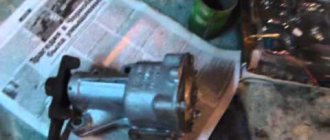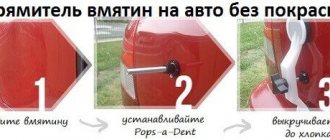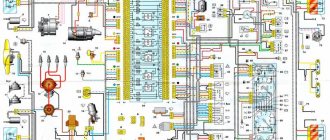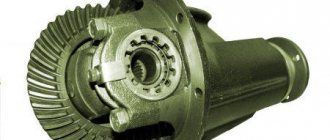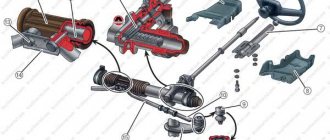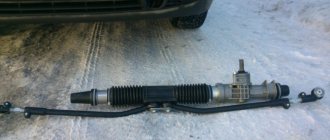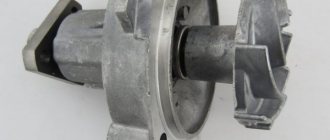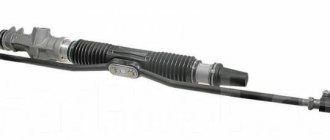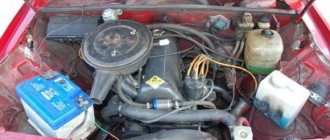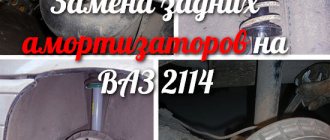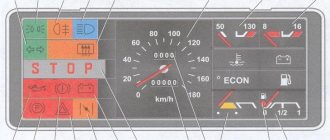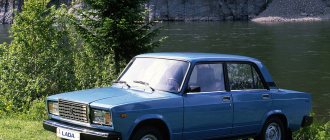The car should always respond clearly to rotations of the steering wheel. If this does not happen, then there can be no talk of any security. This applies to all cars, including the VAZ 2107. The main steering unit is the gearbox, which has its own faults, which can be identified and eliminated without visiting a service center.
- Steering column
VAZ 2107 steering column deviceSteering wheel
- Steering shaft
- Gearbox
- Lubricant leak
- How to remove a column
Video: how to replace the steering gear on a “classic”
- Video: repairing the steering column of classic Zhiguli cars
- Video: how to change the oil in the steering column
- Video: how to reduce play in the classic steering gear
Replacing the steering column or gearbox
Hello again. Thanks everyone for the advice on the steering column.
After reading the information about the repair, I realized that it was not worth the money.
The best option was to purchase a used column in good condition, because... Knowing about the current quality, many will understand me. During the survey, it turned out that Private838
has a normal steering column, which is what I wanted to take.
My grandfather also found out about the problem, and it turned out that a friend of his from the garage had a five-piece gearbox in superb condition. Actually, I got it for myself for seven. For installation I used a steering wheel end puller. The most stressful thing was to unscrew the 3 bolts that secure the gearbox to the body, which was very inconvenient for me personally. In the process, we had to additionally remove the adsorber, the control center, unscrew the locker, remove the wheel and unscrew the cardan from the column shaft
.
the puller is in use, the steering rods are in excellent condition
this is where the oil was flowing, but it was still normal in the gearbox
Oil was also leaking through the side cover.
After comparing the old and new ones, it turned out that my gearbox was a little tight to spin behind the bipod, but with the new one everything was fine. The adjusting screw in my column was recessed flush. The new one stuck out about 4 mm.
old and new
you can see how much the regs are screwed in. screws
place where the cardan is disconnected from the shaft
Then I put everything back in place. In order not to calculate the position of the steering wheel, which was not deployed correctly, I simply removed it and put it in place. I left the old oil in the column because it was yellow. I just topped up a few cubes of Lukoil mineral water.
everything is collected
syringe and oil
Result. After adjusting the steering wheel and driving around, I realized that the controls had changed beyond recognition. If earlier on bumps the steering wheel sat gently in your hands, now it began to be knocked out. On a flat road he stands straight and does not move. Previously, he was wobbling in all directions. In general, I'm pleased.
Among the tips for improving the service life of the speaker, I can say:
1. It does not need to be tightened when adjusting; there should not be much play. 2. Do not turn the steering wheel in a place where it is difficult to turn (asphalt and other surfaces where there is more friction).
Good luck to everyone, may the quality of spare parts be with you!
Installation and repair of the steering column on a VAZ 2107
One of the elements of the VAZ 2107 car, which received a number of improvements in this model compared to the previous ones, is the steering column.
How is its device different? In the VAZ 2107, the steering column shaft consists of two parts connected by a cross. Thanks to this design, driver safety is significantly increased, since in the event of a collision the shaft simply bends at the hinge joint and does not cause serious harm to the person. Also, the shaft in the VAZ 2107 has bearings, so turning the steering wheel requires much less effort. The steering column of the VAZ 2107 consists of a shaft with an articulated joint and a gearbox with a worm gear. Column repair is a very rare occurrence. If you ensure timely maintenance of this unit, it may never be needed. Steering column maintenance work includes lubricating the steering shaft joint, tightening the steering wheel nut, changing the oil and adjusting the gearbox. Let's look at possible problems associated with the steering column and methods for eliminating them.
Steering column device
The purpose of the steering wheel shaft (steering column) is to transmit torque from the steering wheel to the worm gear of the steering mechanism. The VAZ 2107 column (injector), like similar units on all AvtoVAZ classic models, is rigidly attached to the car body using a bracket. Structurally, the column consists of a pair of hinges that can fold in the event of an accident. This ensures driver safety. To facilitate control, the upper shaft of the column rotates on a pair of needle bearings, the condition of which determines the force of rotation of the steering wheel.
STEERING WHEEL PLAY
The appearance of steering play can be caused by two reasons. First, the nut securing the steering wheel to the shaft is loosened. If the nut is not tightened promptly, the splines on the handlebar and shaft will become damaged over time and one of these parts may need to be replaced. The second reason may be wear of the worm gear. To eliminate this malfunction, a special device is provided - an adjusting bolt with a lock nut.
In order to adjust the worm gear, the nut is released, the screw is turned using a screwdriver until the backlash is eliminated, after which the nut is tightened to prevent spontaneous unscrewing. If it is impossible to eliminate the backlash by adjustment, it means that the gearbox needs to be repaired and the worm pair replaced.
To prevent premature wear of gearbox parts, periodic monitoring of the oil level and its replacement is recommended. Level control is carried out as follows:
- Using a 8 key, unscrew the filler plug;
- Use a screwdriver or other object to check the oil level. It should be level with the bottom edge of the filler hole.
- If necessary, add oil using a special supercharger until it begins to flow out of the hole.
To change the oil, unscrew the screws securing the gearbox cover, having previously placed a container under it to collect used oil. Since complete removal of the cap is not required, it is moved to the side and the oil is drained. This operation is best performed on a hot engine. Warm oil has greater fluidity and drains faster. After all the oil has drained out, the cap is screwed into place and new oil is poured into the gearbox using the method described above.
everything useful is here
Replacing the steering shaft
Remove the negative terminal from the battery. Remove the steering wheel, steering shaft mounting bracket covers, steering column switches, disconnect the ignition switch connector
Using a 13mm wrench, unscrew the nuts from the coupling bolts of the intermediate shaft universal joint forks and remove the bolts.
Using a 10mm wrench, unscrew the two shear screws securing the steering shaft bracket.
If the bolts have their heads cut off, then use a chisel to loosen the tightening of the remaining round heads and finally unscrew them with pliers. Locking washers are installed under the screws. Using a “13” wrench, unscrew the two nuts securing the steering wheel bracket......and remove the bracket. Remove the upper shaft from the splined joint with an intermediate shaft. Remove the intermediate shaft from the splines of the gearbox worm shaft. Flare the curved edges of the bracket pipe on the steering wheel side, insert the key into the ignition switch and turn off the lock. With light blows we knock the shaft together with the bearing out of the pipe.
The second bearing can be knocked out using a suitable piece of pipe. The needle bearings are installed in shock-absorbing plastic cages. If the shaft or its bearings are worn or damaged, replace them.
Install the steering shaft in the reverse order of removal. Before finally tightening the steering shaft bracket, turn the steering wheel in both directions several times to self-install the bracket.
If it is necessary to remove only the steering gear reducer, unscrew the bolt securing the lower end of the intermediate steering shaft to the worm shaft and the bolts securing the gearbox to the body side member.
Install the steering shaft in the reverse order of removal.
REMOVAL OF THE GEARBOX
The design of the gearbox does not allow it to be repaired without removing it from the vehicle. In order to remove it, you must:
- Disconnect the tie rod ends from the gearbox. First, they are uncoiled, then the nuts are unscrewed with a 22 wrench and the tips are pressed out using a special puller.
- Unscrew the clamp securing the steering shaft to the gearbox.
- Remove the three bolts that secure the gearbox to the car body.
The gearbox design should not cause any particular difficulties when repairing it. You just have to take into account that the worn elements, called the worm pair, are both replaced at the same time. After this, adjustments must be made.
Steering mechanism VAZ 2107
VAZ cars, which are classic models, are distinguished by pleasant reliability. This also applies to the steering mechanism.
It is quite complex, but its design allows you to maneuver and ensure reliable vehicle control even in the most difficult road conditions.
The modernization process led to the installation of a composite shaft and a safety column. Due to the size of the steering wheel, the driver makes the necessary maneuvers without any problems. From lock to lock, it takes 3.5 turns to turn the steering wheel completely. The force from the steering column is transmitted to the drive via a composite shaft.
The current steering mechanism on the VAZ 2107, a product of the Volga Automobile Company, is quite informative and does not allow the driver to get tired during long trips. There are certain difficulties when turning in a parking lot, but as soon as the car begins to move, the resistance weakens and turning the steering wheel becomes easier.
There is one more nuance - when the steering mechanism is working properly, there is a slight play. But its limit value complies with the traffic rules. This is due to the fact that there are steering rods on the VAZ 2107 and an impressive number of elements in the gearbox.
In general, the steering of the 7 can be considered reliable.
↑ Checking the ball joints of the steering rods
- First of all, check the movement of the rod tips along the axis of the fingers. To do this, using the lever and support, move the tip parallel to the axis of the finger.
- The axial movement of the tip relative to the finger should be 1–1.5 mm. This movement indicates that the pin insert is not jammed in the rod tip socket and moves along with the pin, compressing the spring. Replace the hinge with a jammed insert.
- While rocking the steering wheel in both directions, check by touch that there is no free play in the steering rod joints. If you feel free play in the ball joint, replace the tie rod end or tie rod assembly.
- Check the condition of the protective caps of the steering rod ball joints.
- If the protective caps are in good condition and ensure cleanliness inside the hinges, then the service life of the latter is practically unlimited. When moisture, dust, etc. gets into the hinge, premature wear of its parts occurs.
The cap must be replaced if it has cracks, ruptures, and also if lubricant penetrates out when squeezing it with your fingers.
Mechanism design
To repair the steering column on a VAZ 2107, you first need to understand its structure, as well as the principle of operation.
The seven is in many ways similar to the “penny”. Therefore, the device and design received minor changes. The structure includes:
- A mechanism that transmits the driver’s force to the executive components;
- A steering drive that turns at an angle specified by the driver.
In turn, the steering mechanism consists of:
- Composite shaft with cardan transmission;
- Steering wheel (steering column together with a steering wheel with a diameter of 520 mm);
- Worm gearbox of the VAZ 2107 steering mechanism.
The control system has the following components:
- Bipod;
- Pendulum arm;
- Swivel arms;
- Steering rods for VAZ 2107 (one middle, two side).
The outer rods include two parts, which allows you to change their size by adjusting the toe angle.
Tie rod/end set for VAZ 2107
The operating principle of the steering mechanism looks like this:
- The driver begins to rotate the steering wheel, the wheel size of which ensures that this task can be performed quite simply;
- By means of a composite shaft, a worm gear is activated, which reduces the speed;
- The steering mechanism is lubricated with special oil (TAD 17) poured into the gearbox;
- The worm gears rotate, which causes the double ridge roller to move;
- This, in turn, causes the secondary shaft to rotate;
- The tray mounted on the secondary shaft makes a turn and pulls the rod system behind it;
- These components influence the levers that synchronously rotate the wheels to the required angle specified by the driver.
Parts of the steering gear housing: 1 - housing; 2 - bipod; 3 — lower crankcase cover; 4 — adjusting shims; 5 — outer ring of the worm shaft bearing; 6 — separator with balls; 7 — bipod shaft; 8 - adjusting screw; 9 — adjusting plate; 10 — lock washer; 11 - worm shaft; 12 — upper crankcase cover; 13 - sealing gasket; 14 — bipod shaft sleeve; 15 — worm shaft seal; 16 — bipod shaft seal.
Steering column parts: 1 — steering gear housing; 2 - shaft seal; 3 - intermediate shaft; 4 - upper shaft; 5 — fixing plate of the front part of the bracket; 6 — bracket for fastening the steering shaft; 7 - upper part of the facing casing; 8 — bearing sleeve; 9 — bearing; 10 — steering wheel; 11 — lower part of the facing casing; 12 — bracket fastening parts
The middle link is solid, has ball pins at the ends for connection with the pendulum arm and the steering bipod.
Each extreme rod consists of two threaded ends connected to each other by adjusting couplings. The adjusting couplings are fixed to the rods using two tie clamps.
Each of the rods has ball joints at the ends for connection with the steering axle arms, pendulum arm or steering bipod.
By rotating the couplings, the length of the side rods changes when adjusting the wheel toe.
Note. For cars produced since December 1971, the design of the steering axle levers has been changed: the surface of the lever in contact with the rubber protective cap of the ball joint, on the new levers, is lowered 17 mm below the axis of the hole for the lower bolt securing the lever to the steering axle. For levers of the previous design, the axis of the hole lies almost in the same plane with the indicated surface. In this regard, when replacing one of the levers of the old design with a new one on cars manufactured before December 1971, it is necessary to simultaneously replace the other lever.
Rice. 1. Steering: 1 — steering mechanism; 2 — bolt securing the barter steering mechanism to the body; 3 — adjusting washer; 4 and 14 - flat washers; 5 - nut; 6 and 11 — spring washers; 7 — bolt for tightening the steering shaft on the worm shaft; 8 — shaft seal; 9 — bolt securing the rubber seal to the body; 10 — steering shaft; 12 — bolt securing the bracket to the body; 13 — steering shaft bracket; 15 — steering wheel; 16 — nut securing the wheel to the steering shaft
Rice. 2. Parts of the steering drive: 1 - right arm of the steering axle; 2 — bolt of the coupling clamp; 3 — outer right tip assembly; 4 and 11 — adjusting clutch clamp; 5 and 14 — spring washers; 6, 15, 31 — nuts; 7— clamp of the adjusting coupling; 8 — inner right tip; 9 — middle rod assembly; 10 — inner left tip; 12 — adjusting clutch; 13 — left steering axle lever; 16 — outer left tip assembly; 17 — adjusting clutch clamp; 18 — dirt cap; 19 — nut securing the rod end to the steering arm; 20 and 30 - cotter pins; 21 — bolt of the clamp; 22 — nut for fastening the pendulum arm; 23 - flat washer; 24 — axis of the pendulum lever; 25 and 28 — seals; 26 and 33 — bushings; 27 — bracket for the pendulum arm; 29, 35 and 36 - washers; 32 — upper washer; 34 — nut of the bracket fastening bolt; 37 — bracket fastening bolt; 38 – adjusting clutch; 39 — pendulum lever
—
The steering is used to ensure the vehicle moves in the direction specified by the driver. It consists of a steering mechanism and a steering gear. When a car turns, each wheel moves in its own circle. In order for the wheels to roll without slipping, it is necessary that the extensions of the axes of all wheels intersect at one point, which is called the center of rotation of the car. When turning, the outer front wheel describes an arc of a larger radius, and the inner one - a smaller one, therefore, it is necessary to turn the wheels at different angles. The inner wheel turns at a larger angle, and the outer wheel turns at a smaller angle. This is ensured by a steering linkage consisting of a front suspension beam, steering arms of the front wheel axles, a middle (long) and two short steering rods.
The steering mechanism serves to transmit and increase the force applied by the driver to the steering wheel to the steering gear. It consists of a steering shaft with a steering wheel and column, a crankcase, a globoidal worm with bearings and a double-ridge roller, which rotates on the axis of the steering bipod shaft head on a double-row angular contact ball or on needle bearings. The worm is mounted on two tapered roller or angular contact ball bearings located above and below the worm in the steering gear housing.
The steering gear transmits force from the steering mechanism to the steered wheels and is located behind the axle of the front wheels. It consists of a steering bipod pivotally connected to the middle rod, a pendulum lever, short rods and levers, and rotating struts of the front wheel axles. When you turn the steering wheel, the steering shaft, the worm and, through the roller, the steering bipod shaft turn along with it. The bipod moves the rod and through it the lever and rods, turning the left and right wheels.
Rice. 3. Steering mechanism: a - Moskvich car; b - VAZ; c — 3A3; 1 - worm; 2 — adjusting nut; 3, 4, 21— counter nuts; 5 — adjusting sleeve; 6 and 19 — oil filler plug; 7 — crankcase cover; 8 - roller; 9— roller axis; 10 — steering shaft; 11 — steering bipod shaft; 12 — oil seal; 13 — steering bipod; 14 — adjusting shims; 15— gasket of the adjusting screw; 16 — adjusting screw; 17—adjusting plug; 18 — lock nut; 20 — adjusting screw; 22 — coupling bolt. clamp; 23 - oil level inspection hole bolt
Rice. 4. Steering gear: a - diagram of the Moskvich steering gear: 1 - left steering column lever; 2 — outer tip of the left short rod; 3 — adjusting coupling; 4 - left and right short rods; 5 — steering bipod; 6 — average thrust; 7 — pendulum lever; 8—lock nut with left-hand thread; 9 — lock nut with right-hand thread; 10 — outer tip of the short tie rod; 11 — right arm of the axle pivot strut; 12— rotary stand; b — ZAZ steering gear diagram: 13 — middle thrust locknut with right-hand thread; 14 — lock nut with left-hand thread; 15 — average thrust; 16 — pendulum lever; 17 — hole for turning the rod with a crank; 18 — steering bipod; 19 — steering axle lever; 20 - short thrust; 21 — turn limiters
—
In front-wheel drive vehicles, more load is placed on the front wheels, which requires more effort to turn them. Therefore, such cars use steering mechanisms with a large gear ratio and a higher efficiency.
Vehicles are equipped with a safety steering system with a rack and pinion steering mechanism. This type of steering is compact and simple in design, more technologically advanced in manufacturing and goes well with the front-wheel drive layout of the car and the transverse arrangement of the power unit. In order to increase passive safety, the steering wheel has a damping element.
The steering system consists of a steering gear and a steering gear.
The steering mechanism assembly with steering rods is attached with two brackets to the front panel of the body. To dampen vibrations, rubber cushions are installed between the crankcase and the panel, as well as on both crankcase supports.
The crankcase (of the eul mechanism is cast from aluminum alloy together with the left support. A drive gear is installed in the cavity of the crankcase on ball and roller bearings. The ball bearing on the gear shaft is fixed with a retaining ring. The outer ring of the bearing is pressed against the end of the crankcase socket by a nut, in the recess of which an O-ring is installed with a protective washer. The nut is locked in the crankcase with a washer and covered with a boot, which is mounted on the drive gear shaft. Marks A and B are made on the steering gear housing and on the boot for proper assembly of the steering mechanism.
Rice. 5. Steering assembly: 1 — tie rod end; 2 — ball joint of the tip; 3 — rotary lever; 4 - nut; 5 — adjusting rod; 6 — left tie rod; 7 — bolts securing the steering rods to the rack; 8 — right steering rod; 9 — bracket for fastening the steering mechanism; 10 steering gear support; 11 — protective cover; 12 — connecting plate; 13 — locking plate; 14 — rubber-metal hinge; 15 - sealing ring; 16 — rack support sleeve; 17 — rack; 18 — steering gear housing; 19 — coupling coupling bolt; 20 - plastic coupling; 21 — upper part of the facing casing; 22 - damper; 23 steering wheel; 24 - ball bearing; 25 — steering shaft; 26 lower part of the facing casing; 27— steering shaft mounting bracket; 28 — protective cap; 29 — roller bearing; 30—drive gear; ball bearing; 32 — retaining ring; 33 — protective washer; 34 - sealing ring; 35 — bearing nut; 36 boot; 37 — sealing ring of the stop; 38 — retaining ring of the stop nut; 39 — rack stop; 40 - spring; 41 — stop nut; 42 — ball joint pin; 43 — protective cap; 44 — ball pin insert; A - mark on the steering gear housing; In the mark on the boot
The gear is in mesh with a rack, which is pressed against the gear by a spring through a metal-ceramic stop. This stop is sealed in the crankcase with a rubber ring. The spring is pressed by a nut with a locking ring that prevents the nut from being unscrewed. Due to the spring-loaded stop, backlash-free engagement of the gear with the rack is ensured over the entire stroke of the latter. The rack rests on the stop at one end, and on the split plastic sleeve at the other. There are grooves on the outer surface of the bushing into which rubber sealing rings are installed. The rack bushing has three protrusions that fit into the sockets of the steering mechanism housing when installing it, thereby protecting the bushing from axial displacement and from turning.
A protective cap is put on the steering gear housing on the left side, and a pipe with a longitudinal groove is pressed onto the right side. The bolts that secure the steering rods to the rack pass through the groove of the pipe and the holes in the protective cover. The bolts are connected to each other by a plate. Both bolts pass through rubber-metal hinges pressed into the heads of the rod ends. The bolts are secured with a locking plate.
The travel of the rack is limited on one side by a ring pressed onto the rack, and on the other by the bushing of the rubber-metal rod joint. In this case, both the ring and the bushing rest against the steering mechanism housing. The cavity of the steering gear housing is protected from contamination by a corrugated cover, which is secured with two plastic clamps, as well as a protective cap.
The steering shaft is connected to the drive gear by an elastic coupling. The upper part of the shaft rests on a radial ball bearing with a plastic sleeve, which is pressed into the bracket pipe. At the upper end of the shaft, the steering wheel is secured with a nut on splines through a damping element.
The steering shaft mounting bracket is attached at four points to the body bracket. A connector for the steering column switch is mounted on the bracket pipe, and the contact part of the sound signal is attached to the lower end of the damping element. The steering column switch and the horn switch are covered with a protective casing consisting of upper and lower parts connected with screws.
The steering drive consists of two horizontal rods and rotary arms of telescopic front suspension struts. Composite rods. When adjusting the toe-in of the front wheels, the length of each rod is changed by a tubular rod, which is screwed onto the rod ends and secured with nuts.
The head of the outer tip contains parts of a ball joint, consisting of an insert and a ball pin, a spring and a protective cap. The plastic liner, together with the pin, is constantly pressed by a spiral spring against the conical surface of the tip bore. Due to the presence of a longitudinal cut in the liner, the gap between the liner and the finger is automatically selected.
The other end of the spring rests against a plug rolled into the tip. The joint cavity is sealed with a protective cap, which at one end fits into the bore of the tip, and the other is tightly fitted onto the finger.
The swing arm is welded to the front suspension strut housing. A bushing with a conical hole for the ball joint pin is mounted into it.
The steering mechanism parts are lubricated with Fiol-1 lubricant, which is placed in the mechanism housing and on the parts during assembly of the mechanism, and the ball joint parts are lubricated with ShRB-4 lubricant, also during assembly. During the operation of the vehicle, the steering parts are not additionally lubricated, except in cases of damage to the protective covers and caps, when it is necessary to disassemble the steering control and replace the lubricant, caps, covers, and possibly other damaged parts. All these operations should be performed at a service station.
Steering Maintenance
After the first 2,000 km, and then every 15,000 km, it is necessary to check the condition of the steering rod ball joints, protective rubber covers and caps, and the free play of the steering wheel.
Checking the condition of the steering should be carried out by two people, on an overpass or inspection ditch. First of all, you need to make sure that the steering wheel spoke is horizontal with the wheels in a straight position. If the spoke deviates from the horizontal, it is necessary to determine the cause of the malfunction and eliminate it. Basically, this malfunction occurs due to improper assembly of the steering mechanism and to eliminate it, you must contact a service station.
By turning the steering wheel from lock to lock, you need to check by inspection and by ear: - the reliability of the fastening of the steering mechanism and the steering wheel; — no play in rubber-metal joints and ball joints of steering rods; — reliability of tightening and locking the bolts securing the rods to the rack and the nuts of the ball joint pins; — no jamming or interference that prevents the steering wheel from turning.
Loose connections must be tightened.
If knocking and jamming is detected, it is necessary to disconnect the rods from the rotary arms of the telescopic suspension struts and repeat the check. After making sure that the knocking and jamming comes from the steering control, you need to remove it from the car and replace it with a new one or have it repaired at a service station.
Rubber-metal hinges must be replaced if the rubber bushings have bulging, ruptures or free play (play) in the hinges.
If the protective cap of the steering rod ball joint has cracks, the cap must be replaced, first adding ShRB-4 lubricant to it. The cap must also be changed if, when squeezing it with your hands, the lubricant comes out.
You should make sure that the protective cover is securely fastened and that it is sealed. When turning the steering wheel, you need to check whether the protective cover has any bulges or pinches. Otherwise, it is necessary to determine the cause of the malfunction and eliminate it.
Basic steering malfunctions and ways to eliminate them
The procedure for identifying and eliminating some faults is discussed in the “Steering Maintenance” section.
Increased free play of the steering wheel. Causes of the malfunction and ways to eliminate it: - loosening of the nut securing the ball pins of the steering rods. Check and tighten the nuts; — increased clearance in the ball joints of the rods. Replace the rod ends; — wear of rubber-metal joints of rods. Replace rubber-metal hinges or rods; — loosening the rack stop nut. Adjust the steering mechanism at a service station and replace damaged parts; — wear of the bushings of the elastic coupling of the steering shaft. Replace flexible coupling.
Noise (knocking) in the steering. Causes of the malfunction and ways to eliminate it: - loosening of the nuts of the ball joints of the rods. Check and tighten the nuts; — loosening the rack stop nut. Adjust the steering mechanism at a service station and replace damaged parts; — loosening of the steering mechanism. Tighten the fastening nuts; — loosening the bolt securing the lower flange of the elastic coupling to the gear shaft. Tighten the flange bolt.
Stiff rotation of the steering wheel. Causes of the malfunction and ways to eliminate it: - damage to the bearing of the upper support of the suspension strut. Replace the bearing or support assembly; — damage to the support sleeve or rack stop. Replace damaged parts and apply lubricant. It is recommended to perform these operations at a service station; — low pressure in the tires of the front wheels. Set tire pressure to normal; — damage to ball joint parts. Replace damaged parts; — damage to parts of the telescopic stand. Replace or repair the suspension strut.
Repair and maintenance
Over the years of operation it has been proven that the steering on VAZ 2107 vehicles has impressive reliability. However, this does not take away the fact that the machine requires periodic inspection and repair.
- When performing maintenance, it is important to check for increased play as well as increased wear on the ball joints. To do this, you need to turn the steering wheel from one side to the other. If the wheels do not respond when the steering wheel is turned 5 degrees from its original position, this indicates severe wear. Here you will need to repair the steering column on a VAZ 2107.
- To avoid the need for urgent and rather expensive repairs of the steering gear on a VAZ 2107, it is necessary to change the oil in the worm gear housing. This is done at intervals of 60 thousand kilometers. Leaks may occur through the seals, so they are carefully checked 2-3 times a year. This is one of the weak points of the system.
- The swing arm should be inspected by slowly rotating the steering wheel from side to side. If the parts move in a vertical plane, then surgical intervention is required.
If any malfunctions are detected, the breakdowns should be repaired immediately.
To do this, the drive and steering mechanism are dismantled completely or partially. Everything depends directly on the nature of the breakdown.
Check which parts have defects and what has failed. Inspection is required for each component of the mechanism. If parts are worn out, there is no point in trying to repair them. There is only one way out - a complete replacement of worn-out components of the steering system on a car from a Volga company.
If problems arise with the steering, it is advisable to contact a professional service station.
Photo of the VAZ 2107 steering gearbox
You can replace the gearbox yourself, but the process is complicated and requires at least minimal experience and skills.
The VAZ "Seven" is a true classic of the domestic automotive industry. Unlike modern LADAs, they are more reliable and durable, which is proven by the huge presence of these cars on our roads.
Of course, the VAZ 2107 has long been outdated, it does not have a hydraulic booster, and you have to apply sufficient force to turn and maneuver. But for connoisseurs this is not a problem.
Steering problems
The steering mechanism, like any other vehicle component, wears out and requires repair over time. To simplify the troubleshooting, there are certain signs that allow you to find out the nature of the breakdown and fix it in a short time.
Oil leak
On a classic, the problem of a “wet” steering gear is quite common. There can be many reasons for this:
- oil seal wear;
- leakage from under the gasket;
- loosening of the fasteners that secure the mechanism cover;
- Corrosion of the input shaft.
If the oil seal and gaskets can be replaced and the bolts tightened, then if the shaft is damaged, the part will have to be ground.
Tight steering wheel
Sometimes it happens that to turn the steering wheel it is necessary to apply noticeably more effort than usual. Several reasons can lead to this malfunction:
- incorrect wheel alignment;
- failure of one of the elements in the steering mechanism;
- the gap between the worm and the roller is broken;
- The pendulum axis fasteners are too tight.
Steering play
One of the reasons for free play in the steering mechanism is wear on the shaft crosspieces. In addition to them, play appears in the gearbox itself. If the unit has a high mileage, then it is advisable to disassemble it, inspect the condition of all the elements, replace parts with high wear, and then carry out adjustments.
Knock and vibration
If you feel feedback on the steering wheel while driving, there can be many reasons for this phenomenon. Driving a vehicle in such a technical condition leads to rapid fatigue and reduces the level of safety. Therefore, the steering mechanism needs diagnostics.
Table: causes of vibrations and knocking on the steering wheel and ways to eliminate them
| Cause of steering failure | Troubleshooting method |
| Increased clearance in front wheel hub bearings | Adjust the front wheel hub clearance |
| Loosening the tie rod ball pin nuts | Tighten the tie rod ball stud nuts |
| Increased clearance between the pendulum arm axis and the bushings | Replace the swingarm bushings or bracket assembly |
| The adjusting nut of the pendulum arm axis is loose | Adjust the tightness of the swingarm nut |
| The clearance in the engagement of the roller with the worm or in the worm bearings is broken | Adjust the gap |
| Increased clearance in steering rod ball joints | Replace tie rod ends or tie rods |
| Loosening the bolts securing the steering gear housing or the pendulum arm bracket | Tighten the bolt nuts |
| Loosening the swing arm nuts | Tighten the nuts |
How much does a steering column cost for a VAZ 2107
The cost of a VAZ 2107 steering column in Russia varies from 1,450 to 4,449 rubles .
The steering column of the VAZ 2101-2107 family is a mechanism for transmitting natural force from the steering wheel to the wheels through rotational actions. Inside the column, the steering shaft contacts another gear, forming a worm pair, which, in turn, transmits force to the steering linkage. Inside the case, which is made of silumin (does not oxidize when in contact with liquids), there is an oil bath. The efficiency of the mechanism is also achieved thanks to the following components (included in the repair kit):
- Adjustment screw.
- Worm bearing.
- Stuffing box.
- Bipod shaft bushing.
- Bipod shaft seal.
- Adjusting shim.
- Bipod shaft roller thrust washer.
It is best to buy an original steering column, which differs from analogues not only in the cost of 1,100-1,430 rubles. , but also design features. We are talking about fastenings to the body. These are tear-off fasteners or shear bolts, which, in the event of an accident, will protect the driver from injury from the steering column. In addition, the original speakers 21050-3400010-00 for Lada 2101-07 and a dry weight of 5 kg have reinforced threads on the shaft, which do not deform during shocks from the suspension and other operational features.
Replacing the steering gear of a VAZ 2107 with your own hands
If uncharacteristic sounds are heard while the “Seven” is moving, oil leaks from the radiator, and considerable effort is required to move the steering wheel, repair or replacement of the VAZ 2107 steering gear is inevitable. The unit transmits force from the steering wheel to the performance mechanisms. The unit itself is quite reliable, it is capable of operating stably for up to 300 thousand kilometers, provided that the operating rules are followed. But there comes a time when the unit fails. Do-it-yourself repairs are quite affordable. Before work, you need to stock up on the necessary spare parts, tools, and familiarize yourself with the design.
What affects the cost?
The cost of a steering column is influenced by the following factors:
- Manufacturer.
- Country of origin (Eurasian compliance standards).
- Type of component.
- Type of equipment.
- State.
- Brand.
- Type of spare part.
- Type of modification (without hydraulic booster).
- Model.
- Serial compatibility.
In addition to such key parameters, the cost is also affected by the type of packaging and internal placement of the product. Original steering columns, which have a clear centering position with a noticeable effort to overcome it, regardless of the direction of rotation, are always equipped with an output shaft mounting bipod. The latter prevents its rotation and axial displacements in the bearing and oil seal. Also, the original AvtoVAZ packaging is different:
- Complete with technical data sheet and warranty card (separate sealed bag).
- Security seal with laser engraving on the top and bottom.
- Since February 2016, compliance with Eurasian standards is indicated on the side of the box, instead of specifications.
Also included in the price is the oil used to fill the steering column. During transportation, the adjusting bolt and gasket are in a free state, which requires compliance with the orientation of the product in space.
Types and prices
The original steering column for passenger cars of the VAZ 2101-07 family has catalog number 21050-3400010-00 . Its cost varies from 2,172 to 4,449 rubles . In order for the classification of goods to be as complete as possible on the part of the buyer, the price can be divided by series and compatibility. The latter looks like this:
- VAZ 2102, 1973-1985 – 2,797-4,449 rubles.
- VAZ 2103, 1972-1984 – 2,797-4,449 rubles.
- VAZ 2106, 1975-2006 – 2,430-4,300 rubles.
- VAZ 2101, 1970-1988 – 2,172-4,301 rubles.
- VAZ 2106, 1975-2005 – 2,430-4,250 rubles.
- VAZ 2104, 1984 – 3,934 rubles.
- VAZ 2105, 1981 – 4,012 rubles.
- VAZ 2107, 1982-2012 – 2,640-4,449 rubles.
- VAZ Niva (2121), 1976 – 2,970-4,440 rubles.
- VAZ 2121, 1994-2006 – 2,970-4,440 rubles.
- VAZ 21213, 2001-2006 – 2,700-4,449 rubles.
If we take into account the gradation by series, the pricing policy is as follows:
- 2101, 1970-1988 – 1,450-4,449 rubles.
- 2106, 1975-2005 – 2,797-4,449 rubles.
- 2107, 1982-2012 – 2,400-4,449 rubles.
Prices are given for original AvtoVAZ products and their copies in similar packaging, configuration, as well as manufacturer’s warranty. Each of the items contains oil in the crankcase of the lubrication system.
